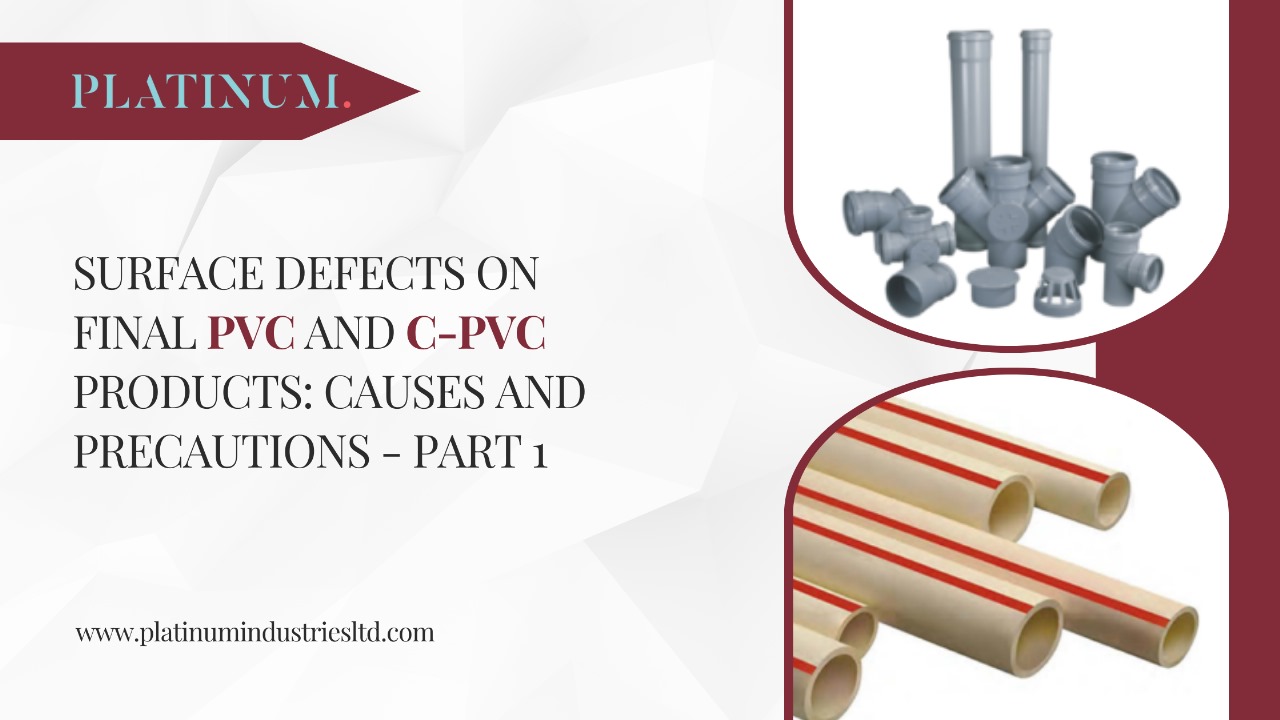In our daily lives, numerous PVC products stand out not only for their durability and functionality but also for their appealing design and flawless appearance. Even when partially buried or installed out of sight, they maintain their high quality. Often, it’s the smallest flaws, such as tiny surface defects like so-called pttings or pitmarks, that can form the basis of a complaint.
Let’s explore the microcosm of pittings:
1. Definition:
Surface defects of PVC products like pittings refers to small, visible, pinpoint irregularities, protrusions, or trapped impurities that may appear on the material’s surface. They become visible to the eye at sizes of approximately 40 to 50 micrometers. Various factors can cause them, such as the quality of raw materials used, cleanliness and orderliness during manufacturing, and the manufacturing process itself. Therefore, it is necessary to meticulously inspect the raw materials used as part of the daily quality control routine.
2. Cause – Visible Contaminations in Raw Materials:
Raw materials, especially extremely cheap raw materials might contain impurities. There a very simple test to check the raw materials for these, the visible contaminations test (VCT). The test procedure described here is based on article “APAG – MS – 010 DETERMINATION OF MECHANICALCONTAMINATION IN METALLIC SOAPS” in “Compendium of Harmonised Analytical Methods Metallic Soaps” by “APAG – The European Oleochemicals & Allied Products Group”, member of CEFIC.
3. VCT procedure:
- Add 100 mL of the dispersing agent in a 250 mL Erlenmeyer flask.(The dispersing agent might be water with or without a detergent in the most cases.)
- Weigh 25 g of sample and add it also into this flask.
- Shake well in order to avoid lumps forming. Mix well with the glass rod, because it helps them concentrate in the centre of the beaker and it is easier to observe them.
- Allow to decant for about 30 seconds and observe the bottom of the beaker. If there are any mechanical impurities they can now be observed and evaluated.
For high quality materials there should not be any visible contamination. If there was found more than one the material should not be used in production. If there was found one it would be recommended to repeat the test three times.
4. Cause – Coarse Particles:
During extrusion, u-PVC reaches a melt temperature of 190 to 198°C, while for p-PVC it’s approximately 150-170°C. Regarding the cause of pitting formation, all raw materials that melt above the lower limit of the achievable melt temperature must be considered ‘non-meltable’ under these circumstances. The sieve residue of such raw materials at 45 micron is crucial because particles above this size do not melt during processing and could form pittings.The test procedure described here is based on article“APAG – MS – 005 DETERMINATION OF OF SIEVE RESIDUE (wet and dry) OF METALLIC SOAPS”in “Compendium of Harmonised Analytical Methods Metallic Soaps” by “APAG – The European Oleochemicals & Allied Products Group”, member of CEFIC and adjusted for PVC stabilisers and additives.
5. Determination of Sieve Residue:
- Procedure(wetmethod):
- Weigh the clean and empty sieve (MT).
- Weigh about 10 g of product, to an accuracy of 1 mg, into a 250 mL beaker
(MS). - Then add 200 ml of acetone.
- Shake well in order to avoid lumps forming.
- Pour the suspension on the chosen sieve.
- Use another 200 mL of acetone to retrieve all product from the beaker.
- Use the brush on the sieve to gently break up any lumps formed while
preparing the suspension. - Let the sieve dry for 10 minutes at least 70°C.
- Weigh the sieve when dried (MG).
- Procedure(drymethod)
- Weigh the clean and empty sieve (MT).
- Weigh about 10 g of product, to an accuracy of 1 mg, on the chosen sieve
(MS). - Shake the sieve carefully in order to facilitate the passage.
- Any lumps can be broken up gently brushing.
- Weigh the sieve with the remaining residue (MG).
- Expressionoftheresults:
%SR @ 45 μm= 100*(MG – MT)/MT
For high quality materials %SR at 45 micron shall be <0.1%.
6. Production and Storing – Precautions:
Orderliness and cleanliness in production and storage are not only essential prerequisites for smooth production processes, health, environmental, and safety. A clean storage and production environment helps to avoid contaminations in PVC products. Dust particles and other impurities can lead to surface defects such as stippling or irregularities during the manufacturing process. These defects can not only compromise the aesthetic quality of the products but also affect their mechanical properties and longevity.
7. Keywords:
#PVC #stabiliser #stabilizer #surface defects #pittings #pitmarks #visiblecontamination #sieveresidue #VCT
The PVC stabiliser market in India is experiencing significant growth and transformation. As the PVC industry expands and environmental concerns become more prominent, the demand for advanced, sustainable stabilisers is expected to rise. Platinum Industries Ltd. has always preempted this boom, investing in technological innovations that can drive the PVC and CPVC stabiliser market towards a high quality, more sustainable and efficient future. Being a member of the Indian Vinyl Council, Platinum Industries Ltd. is among the leading manufacturers of stabilisers that exceed industry standards.
Platinum Industries Ltd., a member of Indian Vinyl Council (IVC)

